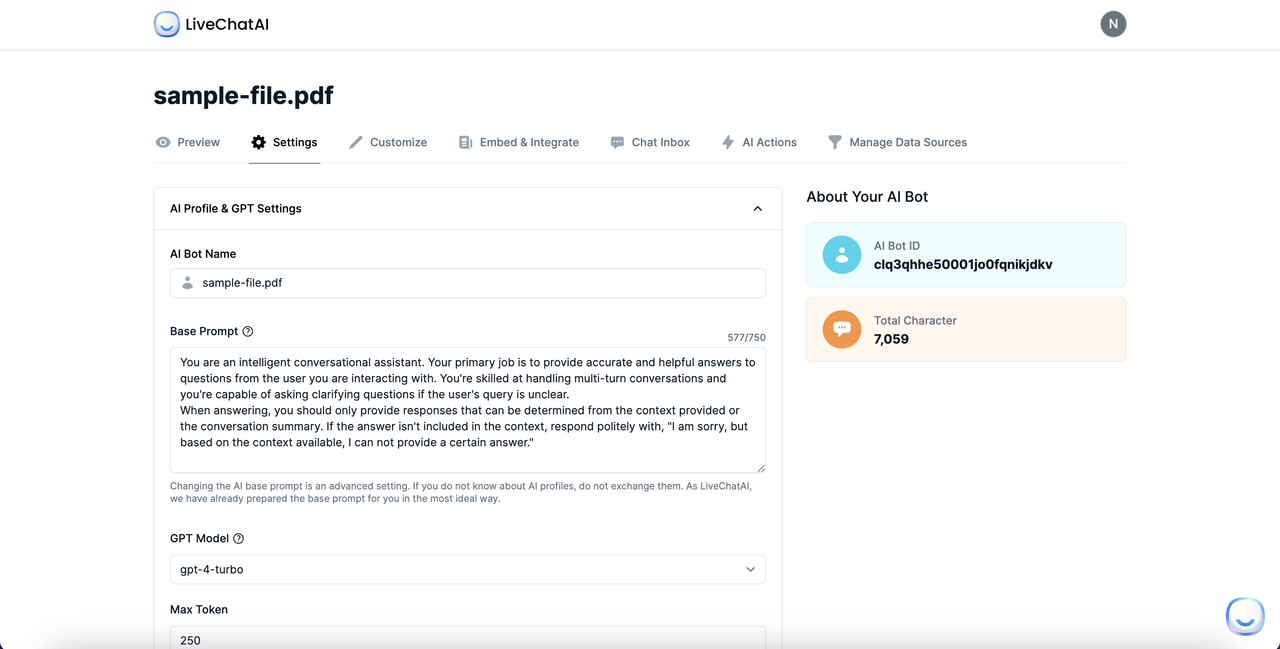
6 Ways to Make Chatbot Sound More Human
AI chatbots have become ubiquitous in enhancing customer experience and streamlining communication. However, the key to unlocking their full potential lies in their ability to resonate with users on a human level.
We will explore why human-like chatbots are essential, the significance of imbuing your bot with a distinct personality, and practical steps to achieve this.
From naming and designing your chatbot to leveraging AI for understanding context and empathy, you will get the nuances of creating a chatbot that responds, connects, engages, and empathizes with users, embodying the warmth and understanding of human interaction in every conversation.

Why Should Chatbots Sound Human?
Chatbots that sound human play a crucial role in bridging the gap between digital convenience and the personalized touch of human interaction. Human-like chatbots are not just about simulating conversation; they're about creating an experience that feels genuine and empathetic.
When a chatbot sounds more like a person rather than a machine, users are more likely to engage in meaningful interactions. This leads to increased customer satisfaction and loyalty.
Human-like chatbots can understand and mimic human emotions, which makes them more effective in handling sensitive or complex customer service scenarios.
They can also adapt their responses based on the user's mood or the conversation context, leading to more nuanced and satisfying interactions.
Moreover, human-like chatbots help reduce the intimidation factor that technology often brings. They can make technology more approachable and less robotic, which is especially important for users who may be less tech-savvy.
Why Your Bot's Personality is Important
- Critical Role in User Perception: The personality of a chatbot significantly influences how users perceive and interact with it, making interactions more enjoyable and memorable.
- Building Brand Identity: A well-defined personality helps in building and reinforcing a brand's identity, making the chatbot an integral part of the brand's voice and values.
- Alignment with Brand Voice: The chatbot's personality should align with the brand's tone. For instance, a professional financial service chatbot should be formal and trustworthy, while a youth-focused brand's bot can be casual and playful.
- Enhancing User Experience: The alignment of the chatbot's personality with the brand's image ensures cohesive and integrated user interactions, enhancing the overall experience.
- Creating Connection and Engagement: A distinct personality transforms a chatbot from a mere tool to a relatable character, fostering a connection that can increase user engagement and loyalty.
- Transcending Functional Role: With a unique personality, a chatbot becomes more than just a functional entity; it becomes a part of the user's lifestyle and daily interaction.
- Importance in the Digital Realm: Integrating human-like attributes and a distinct personality in chatbots is crucial for effective, enjoyable digital interactions and fostering brand loyalty.
6 Ways Techniques to Make Chatbots More Human
Here are the most effective ways and steps to make your chatbot sound more human to find the right tone for your AI chatbot.
1. Establishing a Persona for Chatbots
Creating a persona for your chatbot is about defining its character in a way that resonates with your audience and represents your brand effectively.
This involves choosing specific traits like friendliness, humor, professionalism, or empathy that your chatbot will consistently exhibit.
The persona should be reflected in the chatbot's language style, tone, and even the type of responses it gives.
Having a well-established persona makes the chatbot more relatable and engaging for users, which can significantly enhance the user experience.

2. Providing a More Responsive Experience by Combining Logic and Rules
To make chatbots appear more human, it's essential to design them to respond in a natural and intuitive way.
This can be achieved by combining predefined rules with logical algorithms.
The rules can guide the chatbot on how to respond to specific queries, while logical algorithms allow the chatbot to make decisions based on the context and content of the conversation.
This blend ensures that the chatbot is not only accurate in its responses but also flexible enough to handle a variety of interactions in a human-like manner.
3. Building a Comprehensive Knowledge Base for Chatbots
A comprehensive knowledge base is the backbone of an effective chatbot.
It should contain a wide array of information related to the chatbot’s purpose, including FAQs, technical data, user preferences, and contextual information.
This knowledge base must be regularly updated and expanded based on new information and user interactions.
A well-informed chatbot can provide accurate and helpful responses, which is a key aspect of human-like interaction.

4. Making Your Chatbot a Better Listener
Being a good listener is crucial for human-like interactions.
This involves processing and understanding user inputs accurately, asking follow-up questions for clarity, and responding in a way that demonstrates the chatbot has “heard” and comprehended the user’s needs.
Advanced NLP and AI algorithms can help in interpreting user inputs more effectively, thus enabling the chatbot to respond in a more conversational and engaging manner.
5. Improving Your Chatbot's Ability to Handle Misunderstandings
Misunderstandings are inevitable in any conversation, including those with chatbots.
To handle these effectively, a chatbot should be equipped to recognize when a misunderstanding has occurred and have strategies to rectify it.
This might involve asking clarifying questions, offering multiple-choice options, or redirecting the user to a human agent.
The ability to smoothly navigate misunderstandings is a hallmark of human-like communication.

6. Using Feedback to Improve Chatbot Performance
Continuous improvement is key in making chatbots more human.
Making use of a feedback loop where users can rate their interaction or provide comments on the chatbot’s performance is invaluable.
This feedback can be analyzed to identify areas of improvement, such as response accuracy, conversation flow, and user satisfaction.
Regularly updating the chatbot based on user feedback ensures that it evolves to meet user expectations and preferences, further enhancing its human-like qualities.
6 Steps to Make Your Chatbot Sound More Human
Here are the most effective ways and steps to make your chatbot sound more human to find the right tone for your AI chatbot.
1. Naming Your Chatbot
Choosing the right name for your chatbot is the first step in humanizing it.
The name should be easy to remember and pronounce and preferably evoke the kind of personality your chatbot embodies.
For instance, a financial assistant bot could have a trustworthy-sounding name, while a customer service bot for a tech company might have a more modern, innovative name.
The key is to pick a name that aligns with your brand's identity and the chatbot's intended function.
2. Giving Your Chatbot a Face
The visual representation can significantly enhance the human feel of a chatbot.
By giving your chatbot a face or an avatar, you create a more personable and relatable identity.
Depending on your brand's tone and audience, this could range from a simple, friendly cartoon character to a more sophisticated 3D human-like figure.
A well-designed avatar can make interactions feel more personal and engaging, as it gives users a 'face' to associate with their conversations.
3. Infusing Personality into Your Chatbot
Personality is what sets a great chatbot apart from a merely functional one.
To infuse personality, consider the language and tone your chatbot uses.
→ Should it be formal or casual? Will it use humor? How does it react to different types of queries?
The personality should be consistent across all interactions and aligned with your brand voice.
Crafting a detailed personality guide can help maintain this consistency and guide your chatbot's responses in various scenarios.

4. Teaching Your Chatbot Empathy
Empathy allows chatbots to connect with users on a deeper level.
To make your chatbot empathetic, it should recognize and respond appropriately to users' emotions.
This involves understanding sentiment in user inputs and adjusting responses accordingly.
For instance, if a user expresses frustration, the chatbot should acknowledge the emotion and respond in a way that demonstrates understanding and a willingness to help.
5. Giving Context to Your Chatbot
Contextual understanding is crucial for a human-like conversation.
A chatbot that remembers previous interactions and can reference them in current conversations will seem more intelligent and human.
This requires advanced AI capabilities to track conversation history and use it to inform future interactions.
It helps the chatbot provide more relevant and personalized responses, enhancing the user experience.
6. Making Your Chatbot and Human Agents a Team
Finally, the best chatbot experiences often come from a seamless integration of AI and human support.
The chatbot should be able to handle routine queries and tasks but also recognize when a human agent's intervention is needed.
This transition should be smooth, with the chatbot providing the human agent with the context of the interaction so far.
This collaboration ensures users get the efficiency of AI and the nuanced understanding of human agents, creating a balanced and effective service experience.
Implementing these steps will greatly enhance the human-like qualities of your chatbot, making it not just a tool but an engaging, empathetic, and effective part of your digital strategy.

How to Make Your AI Chatbot Sound More Human with LiveChatAI
Step 1: Start by Creating a LiveChatAI Account.

Step 2: Add Sources for the Knowledgebase.

Step 3: Arrange the Settings of Your AI Chatbot.
At this step, you need to write a proper prompt to make your bot sound more human.
Based on your purpose, you can customize the Base Prompt as well as the AI chatbot itself.

How AI Contributes to Humanizing Your Chatbot
AI enables chatbots to understand natural language, recognize patterns in user behavior, and even predict user needs before they are explicitly stated.
For instance, through machine learning, a chatbot can learn from past interactions and improve its responses over time, making them more relevant and personalized.
AI also allows for the implementation of natural language processing (NLP), enabling chatbots to understand and respond to a wide range of colloquial phrases and expressions, as well as different languages and dialects.
Since AI empowers chatbots with sentiment analysis capabilities, it helps the bot to detect the tone and mood of the user's message, whether it's happy, frustrated, or confused.
The chatbot can then tailor its responses to mirror the user's emotions, showing empathy and understanding, which are key to human-like interactions.

→ The Contributions
One of the most significant contributions of AI in humanizing chatbots is its ability to understand and utilize context in conversations. Contextual understanding goes beyond merely responding to direct queries; it involves remembering past interactions, discerning the current situation, and anticipating future needs.
AI-powered chatbots can keep track of the conversation's history, allowing them to provide more accurate and relevant responses. For example, if a user mentions a problem they faced in a previous interaction, a context-aware chatbot can recall that specific issue and provide an update or further assistance.
Additionally, AI enables chatbots to integrate and analyze data from various sources, such as user profiles or past purchase history, to provide more contextual and personalized interactions. This level of understanding allows chatbots to offer recommendations, solutions, and assistance that are tailored to the individual user's current situation and needs.
Furthermore, AI can enable chatbots to understand the intent behind a user's message, even when it's not explicitly stated. By analyzing the context and the user's typical behavior patterns, the chatbot can proactively offer assistance, suggest relevant products or services, or guide the user through a process, much like a human assistant would.
In essence, embracing AI in chatbot development is not just about automating responses; it's about creating an interactive, empathetic, and contextually aware digital assistant that enhances the user experience and fosters a deeper connection between the user and the brand.
Using Media and Technology to Enhance Chatbot Experience
- Diverse Media Integration:
- Text, Images, Audio, and Video: Utilize a mix of media to cater to different user preferences and enhance interaction quality.
- Visual Aids: Employ images and videos for clear, visual explanations.
- Personal Touch with Audio: Use audio messages, especially in voice-based chatbots, for a more personal interaction.
- Adapting to User Preferences:
- Flexibility: Offer varied media options like detailed text, videos, or audio to suit different user needs.
- Dynamic Interactions: Incorporate GIFs, emojis, and interactive elements to make conversations lively and human-like.

How Natural Language Processing (NLP) Contributes to a More Human Chatbot Experience
→ Understanding and Interpretation:
- Beyond Keywords: NLP enables chatbots to comprehend and respond to human language, including nuances and idiomatic expressions.
- Intent Recognition: Allows chatbots to understand user intent, even in ambiguous or complex phrases.
→ Enhanced Conversation Quality:
- Learning from Interactions: Chatbots improve in understanding speech patterns, accents, and languages over time.
- Sentiment Analysis: NLP helps chatbots detect user mood, facilitating empathetic and context-appropriate responses.
To Conclude
In essence, the journey to humanize chatbots is a blend of art and science.
It begins with understanding the need for chatbots to reflect human qualities, like empathy and personality, to enhance user engagement.
AI plays a pivotal role, particularly in understanding context and processing natural language, making interactions more intuitive and human-like.
Ultimately, the goal is to create chatbots that not only serve as efficient digital assistants but also as engaging, empathetic entities that enrich our daily digital interactions.
For further reading, you might be interested in the following:






